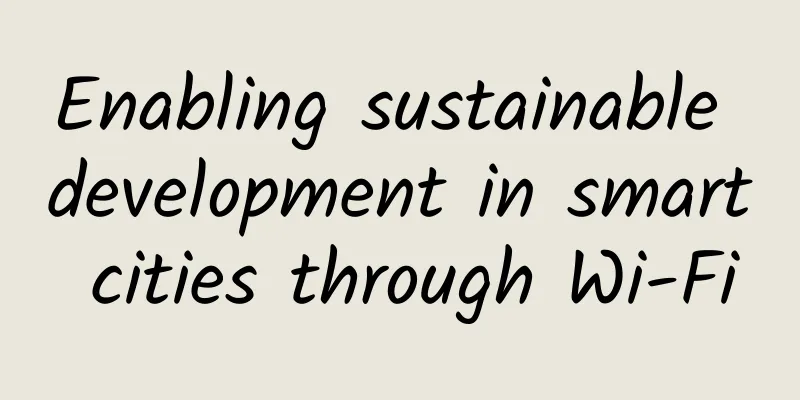Enabling sustainable development in smart cities through Wi-Fi

|
What is the definition of a smart city? The answer is simple; a smart city is a connected city. In order to create it, you need a network that is easily accessible to everyone. The concept is not new in the early 2000s, as Wi-Fi technology became popular, governments and businesses saw the opportunity to create widespread network access for the population, thus creating the concept of “Municipal Wi-Fi”. Entire cities around the world were transformed into giant hotspots. “A smart city is a connected city with different networks from different entities.”So why didn’t it work then, and a decade later it has achieved so much success and traction using the same technology? The answer is simple. The fact is that the strategy and vision at the time were wrong, Wi-Fi was used as an alternative to 3G for Internet access and voice (VOIP was the hot trend at the time). City halls and businesses saw an opportunity to compete with cable and mobile Internet service providers without adding infrastructure and, in some cases, licensing. These networks were created with a single purpose in mind, and due to technological limitations, they failed to deliver. Access points (APs) were deployed in outdoor locations in the hopes of reaching indoors, and Wi-Fi mesh network management was in its early stages, resulting in severe network degradation that translated into a poor user experience (which, unfortunately, is still a problem in some venues today). As a result, the dream of cheap, convenient, and fast Internet access quickly turned into a costly nightmare. Without the expected revenue stream, governments and private entities soon found that maintaining thousands of APs was beyond their means, and these projects were quickly abandoned, with only a few surviving worldwide. About four years ago, the concept resurfaced, but this time the vision was different, mass internet access was no longer the only purpose. Wi-Fi technology had also evolved, and from the few Mbps that 802.11b could provide, it suddenly could reach speeds above 1 Gbps (theoretically). Access points could now connect efficiently, and management was centralized, in some cases hosted in the cloud. They would not compete with 3G/4G, but work together as a seamless transition for the end user or device. This new vision had a multi-purpose application, while previously related entities had all their eggs in the same basket. Wi-Fi APs are able to isolate each SSID into a separate network, turning that hotspot into multiple revenue streams. This network isolation creates perfect conditions for the recent storm of IoT services that has begun. On top of that, venue owners or private entities can deploy Wi-Fi networks and not only provide access to their guests but also rent out their SSIDs. Government entities can monetize their existing Wi-Fi networks and lease parts to mobile network operators (MNOs) for data offloading. Enterprises, i.e., system integrators, can shift their business model to providing Wi-Fi infrastructure for free and securing premium locations so that they can later offer a portion of their Wi-Fi network to interested entities as an OPEX model. MNOs are deploying nationwide Wi-Fi networks around the world not only to provide public Wi-Fi Internet services but also as a valuable asset that can be rented by multiple other MNOs to offload their customer data over their network or to provide VoWiFi services to their subscribers. Utilities can use it to connect their smart meters and governments can use it to provide their e-services. In the age of “as a service”, I can quickly imagine this business model being called “SSID as a service” soon. Wi-Fi networks are no longer just a financial burden, but a business opportunity. In fact, if we look closely at this model, it is easy to confuse it with how real estate works. Houses and apartments located in better locations have a higher value. Imagine that a well-known theme park decides to rent out part of its Wi-Fi network, assigning one SSID to an advertising agency to collect user information for their campaigns. The rental will surely be worth more if compared to a less popular location. This example would apply if an MNO wanted to make a deal to use an existing theme park’s Wi-Fi network to offload its subscribers’ data. Therefore, the theme park’s Wi-Fi network would become a source of revenue, as they would be leasing their “digital space”. When it comes to the Internet of Things (IoT) and Machine-to-Machine (M2M), the same model applies. Smart meters that use cellular networks to push data already exist. Although indoor coverage of cellular networks is not always optimal. In addition, Wi-Fi radio chipsets are 70% cheaper than cellular radio chipsets in some cases. This significantly reduces the cost of equipment when deploying thousands or more smart meters. Not to mention the cost of cellular connectivity for major companies. A viable alternative is to leverage an existing Wi-Fi network, as a dedicated SSID can provide the required security and significant savings in equipment and connectivity. Remember the first sentence when I asked for the definition of a smart city? A smart city is a connected city that consists of different networks from different entities. It provides multiple services and multi-purpose accessibility to everyone and everything. Wi-Fi is at its core, an affordable and efficient access technology that provides a sustainable business model across the smart city ecosystem. |
>>: Is 5G the missing piece of the digital twin puzzle?
Recommend
As 5G private network applications enter deep waters, how can we achieve the goal of going from 1 to N?
At present, the 5G competition has entered the se...
Discussion on SD-WAN development: SD-WAN combined with blockchain technology
As software-defined wide area networks (SD-WAN) b...
The Internet of Things drives the rapid development of the chip industry
With the popularity of the Internet of Things (Io...
Linode: Cloud servers in 24 data centers around the world starting at $5/month, new users get $100 for free
It has been a long time since I shared informatio...
[Black Friday] HostingViet: 50% off Vietnam VPS/email services starting from 160 yuan/month, buy 1 year and get 2 months free
HostingViet has launched a Black Friday promotion...
5G sets new standards for IoT connectivity in vertical industries
As 5G rolls out around the world, verticals acros...
Yan Lida, President of Huawei Enterprise BG: Achieving Dreams and Creating Infinite Possibilities
On September 7, the third day of the All-Connect ...
Neusoft Security - A "practical" company in the field of in-vehicle information security
Since 2000, my country's automobile industry ...
Let’s talk about PHY register, do you know it?
[[383774]] In the previous article, we explained ...
How to choose an operation and maintenance monitoring platform that suits you? Zabbix, Prometheus, Grafana
As an operation and maintenance person, operation...
The turning point has arrived: NB-IoT industry is accelerating its release!
The birth of any new technology is always met wit...
Top 10 SDN Solutions of 2018 (So Far)
Software is the front and center of the network w...
Smartphones supporting Wi-Fi 6/6E will dominate the market by 2025
Wi-Fi 6E will be commercially available in 2021. ...
"Hyper-converged Data Center Network Lossless Ethernet Scenario Level Evaluation Specification" released, Huawei is the first to complete the evaluation
The "2021 Open Data Center Summit" was ...
Huawei and its global partners work together to build a full-scenario smart life
【51CTO.com original article】 Normal 0 7.8 磅 0 2 f...









